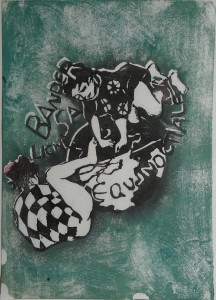Legal terminology often features in French Renaissance comic and nonsense writing, which tells us something about its audience, which would have included students and practitioners of the law. The nonsensical case between Baisecul (Kissarse) and Humevene (Sniffshit) in Rabelais’s Pantagruel is one example – see Souffler au cul.
During the period of festivities known as carnival, lawyers in Paris and elsewhere would plead ’causes grasses’, translated by Randle Cotgrave as ‘Bawdie suits, immodest actions’, absurd cases ‘proving’ things like 11-month pregnancies, which might be handy when proving the legitimacy of a widow’s child (it is also something Rabelais’s narrator, Alcofribas Nasier, attempts to demonstrate of the eponymous giant hero of Gargantua).
Bruscambille similarly has several speeches that are mock legal cases, which must have delighted the law students in his audience. In one such speech he wishes, but ultimately fails, to make a case against a variety of disreputable characters including one who, using the wall as a handkerchief, claimed:
‘not to be to be blame for having really and actually drenched everyone present from the very depths of his underpants, and maintained that he should keep all expenses, damages, and interest, upon which he concluded and, expanding his case, noted that he had bent his equinoctial line, by which he meant his natural crossbow, by way of his dear wife’s bottom, without any other type of legal palaver.’
Devoted readers of the blog may remember the phrase, bend back nature’s crossbow, which has already been the subject of one of Dominic Hills’s prints. The curiously scientific phrase ‘bander sa ligne equinoctiale’ (‘bend the equinoctial line’, technically the line around the earth’s circumference from north to south pole), is part of this more or less nonsensical parody of legal terminology and has inspired another print:
Incidentally, the French term Bruscambille uses for the wife’s bottom is ‘ponant’, literally the west, but also used to refer to the ‘arse, tayle, bumme’, according to Randle Cotgrave. There is clearly something about hemispheres and equinoctial lines that is richly suggestive of other things, something Hills’s print also captures.

